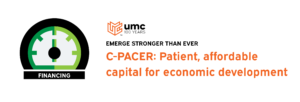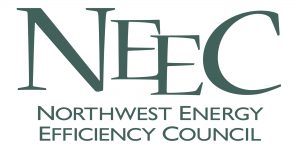This piece is provided courtesy of NEEC member UMC

Preparing communities for success is both harder and more important than ever. What is the future of work and school in a community rebuilding from pandemic? Are you experiencing climate impacts; are you creating jobs in climate solutions? Is your community’s population growing, shifting, why?
No single opportunity can answer all these questions. But for economic developers, it’s good to know of at least one more tool to build on – Washington’s new C-PACER program.
What is C-PACER? For both new buildings and retrofits, C-PACER allows owners of agricultural, commercial, industrial and some multifamily residential properties to access affordable long-term financing from private lenders for qualifying energy efficiency, renewable energy, water conservation, and resiliency measures.i Commercial Property Assessed Clean Energy and Resilience is a new state provision that allows Washington counties to set up their own C-PACER programs for financing new construction and retrofit projects. Whereas C-PACE (no “R”) has already been successful in many states, Washington proudly takes it further with “Resilience” too.
As financing that stays with the property and not a single building owner, a C-PACER loan is treated as an expense rather than a liability, allowing the investment to affordably grow the building’s value without tying the hands of an owner who may wish to sell over time. Programs like C-PACER have enabled financing for over 2,000 property owners in dozens of states and the District of Columbia. Washington’s economic development professionals can affordably improve your community’s commercial infrastructure for the long haul with C-PACER loans.
Local dollars create local jobs cutting carbon.
C-PACER provides another tool for economic development, sustainability, and new job creation, all without raising taxes. According to a PACENation’s 2017 “Economic, Energy, and Impact Report,” every million dollars spent on building improvements through PACE programs has created roughly 7 new jobs – totaling 5,000 so far and growing – across the US.ii And as jobs grow, carbon slows: as of 2017, C-PACE projects are on track to save over 3,000,000 metric tons of greenhouse gas emissions. That’s equivalent to avoiding the climate pollution of 7.5 billion miles driven by an average car.iii
As Washington State builds out its C-PACER opportunity, projects’ investment will put to work area contactors’ expertise: C-PACER can build economic development, job creation, and sustainability, all without raising taxes.
Office workers’ relationships with work have changed since 2020, and many are looking for housing in more suburban and rural environments. CPACER can be another tool to attract and retain talent for your community.
Patient, affordable capital.
C-PACER offers several financing advantages of for commercial properties in Washington. First, it’s patient. Traditional bank loans for energy upgrades are too short – often 7 years – for the energy savings to pay for themselves, substantially limiting what upgrades can be financed effectively. By contrast, C-PACER payment periods can stretch 20-30 years, supporting more extensive energy improvements – like HVAC systems or renewable energy – that provide real value but have a longer payback. Using C-PACER to invest in patient energy savings cuts a building owner’s operations costs and grows their property value.
In addition to C-PACER’s patience, it can offer better cash flows overall than other financing sources, such as mezzanine debt, in a developer’s capital stack. That’s because C-PACER rates may be half as much – currently 4-8% – and are fixed over longer amortization periods.iv This new program’s affordable, patient capital can accelerate economic development for counties in Washington that adopt the program.
Resiliency, unique to Washington.
Washington builds on the success of other states’ C-PACE programs with a unique opportunity for resiliency measures – the “R” in our “C-PACER.” Properties in need of seismic hardening, watershed responsibilities, or other measures could find attractive long-term financing through C-PACER. Whereas energy efficiency upgrades reduce energy bills, resiliency investments reduce insurance costs.
A study by the National Institute of Building Science determined that every resiliency dollar spent beyond code would pay for itself in the future at a 4:1 ratio. For Washington, this means every $1,000,000 spent now by private building owners on seismic preparation could save $4,000,000 in publicly funded disaster relief costs in the future – not to mention the potential for saving lives.v C-PACER allows private investment with a clear public benefit.
C-PACER gets to work.
With Washington State law newly enabling counties to administer C-PACER programs, creating a county C-PACER program is simple: a county adopts an ordinance and guidelines that govern how the C-PACER program works. The repayment of the C-PACER financing is between a private lender and a property owner; a county only records the agreement. Program implementation, such as marketing or education, can be as limited or extensive as suits a county’s needs. Several counties in all corners of the state are in the process of enacting programs to administer C-PACER. Template program documents, experience, and resources are publicly available from the nonprofit ShiftZero coalition as well as C-PACER progress underway from King County, Whatcom County, Spokane County, south Puget Sound, and others.
Does your county already have a C-PACER program for you to put to work? Your voice matters: urge your elected county councilors to take advantage of the easy economic development opportunities of C-PACER.
Authors
Bonnie Frye Hemphill is Director of Policy & Partnerships at UMC. She brings 15 years of experience in climate- and clean-energy policy to drive UMC’s engagement and strategic alliances with a broad range of regional leaders in the built environment.
Michael Bergstrom is Business Developer at UMC focusing on identifying and developing targeted solutions that inspire high performance while reducing utility and operational costs for buildings across the region.
____________________________________
[i] National Law Review, “Keeping ‘PACE’ in Commercial Real Estate Improvements: A Primer on the New Washington Commercial Property Assessed Clean Energy and Resiliency (C-PACER) Program,” https://www.natlawreview.com/article/keeping-pace-commercial-real-estate-improvements-primer-new-washington-commercial (Jun 16, 2020)
[ii] PACE Nation, “Economic, Energy, and Impact Report: C-PACE,” https://www.amesburyma.gov/sites/g/files/vyhlif2731/f/pages/2017-c-pace-annual-impact-report-optimized-1.pdf (2017)
[iii] US EPA, Greenhouse Gas Equivalencies Calculator, https://www.epa.gov/energy/greenhouse-gas-equivalencies-calculator (2020)
[iv]Matthew, Thomas, “Interesting Times Call for Creative Capital: C-PACE, a Financing Alternative,” MarketSpace Capital, https://marketspace.capital/interesting-times-calls-for-creative-capital/ (2020)
[v]National Institute of Building Sciences, https://cdn.ymaws.com/www.nibs.org/resource/resmgr/reports/mitigation_saves_2019/ms_v3_exceeds_earthquake.pdf (2019)
